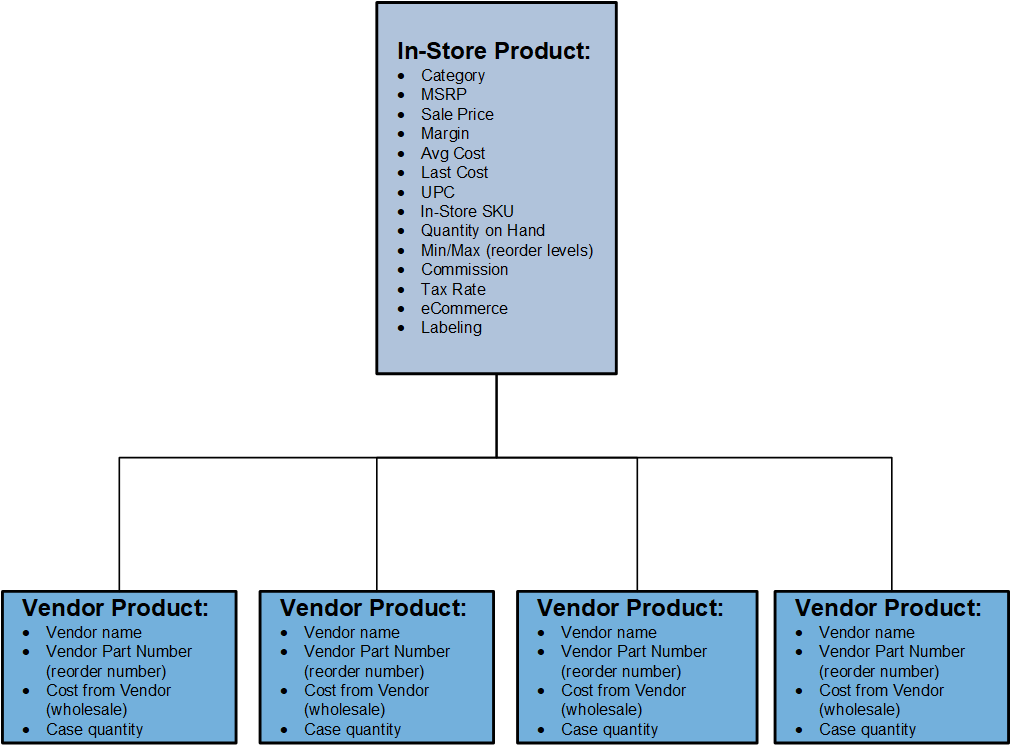Product Types
In-store product
Contains attributes related to selling and stocking a product, e.g. MSRP, category, commission. Each product has a single in-store product record.
Note: Associate at least one vendor product with every in-store product.
Vendor product
Contains attributes related to ordering a product e.g. vendor's cost, case quantity, part number. Each in-store product record can have multiple vendor products.

Attributes Matrix
| Attribute | Vendor products | In-store products |
|---|---|---|
| Is created by vendor updates (using spreadsheets, Update Vendor Products utility, or Cloud Product Catalog) when the product does not exist in your system. |  |
 |
| Is modified by vendor updates (using spreadsheets or the Update Vendor Products utility) when the product already exists in your system. Note: Products are modified only when the Import Only New Products for Vendors option is enabled. Always back up your Ascend system before importing products, even if this option is disabled. |
 |
|
|
Is accessed from the following areas:
|
 |
|
|
Is accessed from the following areas:
|
 |
|
| Can have multiple associated records for different vendors. |  |
|
| Can have multiple associated records for different case quantities. |  |
|
| Stores the cost from a specific vendor. |  |
|
| Stores the Average Cost over receiving history from all vendors. |  |
|
| Stores the quantity currently in stock. |  |
|
| Stores the MSRP. |  |
|
| Stores the identification (part) number for a specific vendor. |  |
|
| Stores the store-specific SKU. |  |
|
| Stores the UPC/EAN for individual items. |  |
|
| Stores the UPC/EAN for the entire case. |  |
|
| Stores the quantity of individual items in a case (Case Qty). |  |
Examples
Note: Prices are for example only, and may not be accurate.
Example 1
A Shimano HG-40 7.4mm Chain can be ordered from Trek, QBP, J&B Importers, or Shimano. No matter from which vendor the chain comes, it has UPC 689228090453 and MSRP $17.99. It is ordered from:
- Trek with Part Number 413063 at Cost $7.50
- QBP with Part Number CH4033 at Cost $9.33
- J&B with Part Number 16175 at Cost $9.79
- Shimano with Part Number ICNHG40116I at Cost $9.29
The chain has one In-Store Product and four Vendor Products.
Example 2
A Teal 16" Verve 2 WSD can be ordered only from Trek. It has:
- UPC 768682286128
- MSRP $499.99
- Part Number 13126011113
- Cost $324.99
The bike has one In-Store Product and one Vendor Product.
Example 3
Original Honey Stinger Waffles can be ordered in a case of 16 individual packets from Trek, QBP, or Honey Stinger. No matter from which vendor the waffles come, the case has UPC 073138740209, the packets have UPC 073138740193, and the packets' MSRP is $1.50 each. The case is ordered from:
- Trek with Part Number 424147 at Cost $11.20 and Case Qty 16.
- QBP with Part Number EB5890 at Cost $13.00 and Case Qty 16.
- Honey Stinger with Part Number 74019 at Cost $11.20 and Case Qty 16.
The waffles have one In-Store Product and three Vendor Products.
Additional Resources
KB22-111
